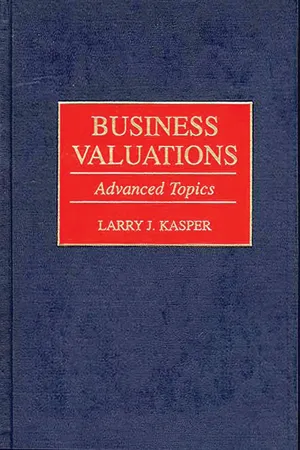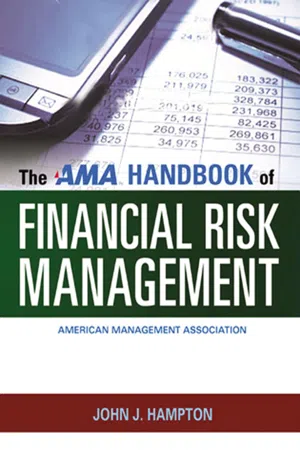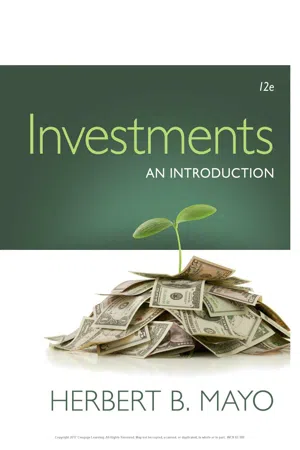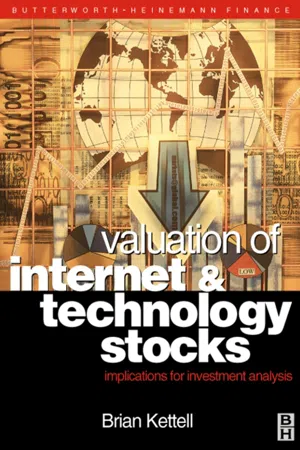Economics
Computing the Price of Common Stock
"Computing the Price of Common Stock" refers to the process of determining the value of a company's common stock. This involves analyzing various factors such as the company's earnings, growth prospects, and market conditions to arrive at a fair price for the stock. Investors use this information to make informed decisions about buying or selling common stock in the financial markets.
Written by Perlego with AI-assistance
Related key terms
1 of 5
9 Key excerpts on "Computing the Price of Common Stock"
- eBook - PDF
Business Valuations
Advanced Topics
- Larry Kasper(Author)
- 1997(Publication Date)
- Praeger(Publisher)
The analysis that follows discusses the determination of the value per share of a common stock. The formulas apply equally well for the entire firm because the value of the total firm is just the number of shares multiplied by the per share value (ignoring possible adjustments for discounts and premiums dis- cussed later). The following terms and conventions are used: E() is the symbol for expected value t is the time period and refers to the end of the period / = 0 refers to the beginning of the period 1 Div is the dividends at the end of period t E is the earnings during period / P is the price per share at the end of period / k is the market capitalization rate. INTRINSIC VALUE We can think of the price that one would be willing to pay for a stock as the current value that equated some future payoff. The trade-off between current value and future payoff has a price. Investors must be paid for delaying con- sumption in the current period to receive value in some later period. That pay- t t 34 THE PARAMETERS OF VALUATION PRACTICE ment is the required return on the investment made today. For any stock, in an efficient market, there exists a consensus rate of return commensurate with the risk associated with holding the stock. The required rate of return that will equate the future payoff of holding the stock with the current value is called the market capitalization rate. Assume that the investor has a one-period investment horizon. The above relationships can be formally expressed as follows. The expected payoff is the sum of the future dividend received at the end of time 1 plus the proceeds from the sale of the stock at the end of time 1, which is equal to the current price in- vested at the required rate of return. P 0 (l + k) = E(Div x ) + E(P X \ ssolving for P 0 E(Di Vl)+ E( 0 (l + k) P 0 is the present value of the expected payoff. - eBook - ePub
- John Hampton(Author)
- 2011(Publication Date)
- AMACOM(Publisher)
Cyclical lows . The market prices of many stocks fluctuate in a cyclical pattern. The stock price may rise for a period of time, possibly with the support of institutional investors. Then, it may be sold to yield some profits for its holders. The result is a pattern of rising and falling prices. The investor may seek to purchase the stock at cyclical lows and sell it near cyclical highs.VALUE OF COMMON STOCK
Present value techniques are used to determine the current value of common stock. In this section, we will examine different valuation approaches.Required Return as Discount Factor
The required return on any investment may be defined as the minimum expected return that is needed if investors are to purchase and hold the asset. It reflects the level of risk offered by the investment. Higher-risk investments require a higher return.In capitalization techniques for common stocks, the time value of money is the required return on the stock. It is used as the capitalization or discount factor in each analysis.Capitalization Rate
This is a measure of the rate of return that investors demand before they will purchase a stock. It is the reciprocal of the price-earnings ratio. The formula is: Capitalization Rate = Earnings per Share (EPS)/Market PriceWe discussed the capitalization rate earlier when we discussed ratio analysis. Now we use it in a valuation framework as the required return for publicly traded common stock. A stock with $6 earnings per share and a current market price of $72 has a capitalization rate of 6/72, or 8.33 percent. This firm earns 8.33 percent on the value of its common stock. If investors did not require this return, they would pay more or less for the stock, and the rate of return would drop or rise.Single-Period Model
The single-period model - No longer available |Learn more
Investments
An Introduction
- Herbert Mayo(Author)
- 2016(Publication Date)
- Cengage Learning EMEA(Publisher)
But in any event, you must have some notion as to the value of the stock in order to justify the purchase. Conceptually, the valuation of a stock is the same as the valuation of a bond or any asset. In each case, future cash flows are discounted back to their present value. For debt instruments this process is relatively easy because debt instruments pay a fixed amount of interest and mature at a specified date. Common stock, however, does not pay a fixed dividend, nor does it mature. These two facts considerably increase the difficulty of valuing common stock. Two approaches, often referred to as “fundamental analysis,” are used to value a stock: discounted cash flow and analysis of financial statements. Discounted cash flow models require estimating future sales, expenses, earnings, and dividends and express -ing these values in the present (i.e., discounting future cash flows). This present value is compared to the current price of the stock to make a buy or sell decision. Analy -sis ofuni00A0financial statements employs a variety of ratios such as price-to-earnings (P/E), price-to-book value (P/B), price-to-sales (P/S), return on equity (ROE), and debt-to-equity (D/E). These ratios may be compared to industry averages or to a predetermined critical value to determine if the stock should be bought or sold. Initially this chapter lays out the basic, logical framework associated with fun -damental analysis. Next the chapter covers an investor’s expected return: the sum of anticipated dividends and capital gains. This return is then used as a required return in a model that discounts future dividends to value the stock. After this initial presenta -tion, the dividend-growth model is expanded to include the capital asset pricing model, which adjusts the required return for the systematic risk associated with the stock. Many companies do not pay cash dividends, so a discounted dividend model can -not be applied. - eBook - PDF
Valuation of Internet and Technology Stocks
Implications for Investment Analysis
- Brian Kettell(Author)
- 2002(Publication Date)
- Butterworth-Heinemann(Publisher)
Valuation techniques for traditional common stocks 45 The required rate of return An investor who is considering the purchase of a common stock must assess its risk and, given its risk, the minimum expected rate of return that will be required to induce the investor to make the purchase. This minimum expected return, or required rate of return, is an opportunity cost. The required rate of return, capitalization rate and discount rate are interchangeable terms in valuation analysis. While in theory we know what this variable is, in practice it is not easy to determine the precise number to use. Because of this complex-ity, we will generally assume that we know the capitalization rate and concentrate here on the other issues involved in the valuation of stocks. The expected cash flows The other component that goes into the present value frame-work is the expected stream of cash flows. The value of common stock is the present value of all the cash flows to be received from the issuer. The questions that then arise are as follows: (1) What are the cash flows to use in valuing a stock? (2) What are the expected amounts of the cash flows? (3) When will the expected cash flows be received? Stockholders may plan to sell their shares at some time in the future, resulting in a cash flow from the sales price. As shown later, however, even if investors think of the total cash flows from common stocks as a combination of dividends and a future price at which the stock can be sold, this is equivalent to using the stream of all dividends to be received on the stock as the key valuation principle. What about earnings? Are they important? Can they be used in valuing a stock? The answer to both questions is a clear Yes. Dividends are paid out of earnings, so earnings are clearly important. The second stock valuation approach, fundamental analysis, to be considered later, uses earnings and a P/E ratio to determine intrinsic value. - eBook - PDF
- Timothy Mayes(Author)
- 2020(Publication Date)
- Cengage Learning EMEA(Publisher)
263 L E A R N I N G O B J E C T I V E S : After studying this chapter, you should be able to: LO1 Differentiate among the definitions of “value,” and explain the importance of intrinsic value in making financial decisions. LO2 Explain how intrinsic value is calculated by considering the size, timing, and perceived riskiness of the cash flows. LO3 Explain the concept of “required rate of return,” and calculate this rate using the Capital Asset Pricing Model (CAPM). LO4 Use several discounted cash flow (DCF) models to value a common stock. LO5 Use relative valuation models, especially for stocks that do not meet the assumptions of DCF models. Common Stock Valuation C H A P T E R 9 Determining the value of financial assets is important to both investors and corporate financial managers. The obvious reason is that nobody wants to pay more than an asset is worth, because such behavior would lead to lower returns. Less obvious, but equally important, is that we can draw some valuable conclusions from the observed prices of assets. We will examine one of these conclusions in detail in Chapter 11 when we use the market value of corporate securities to determine the required rate of return on investments. Copyright 2021 Cengage Learning. All Rights Reserved. May not be copied, scanned, or duplicated, in whole or in part. Due to electronic rights, some third party content may be suppressed from the eBook and/or eChapter(s). Editorial review has deemed that any suppressed content does not materially affect the overall learning experience. Cengage Learning reserves the right to remove additional content at any time if subsequent rights restrictions require it. CHAPTER 9 Common Stock Valuation 264 In this chapter we will look at several models that can be used to determine the value of a share of common or preferred stock. What Is Value? The term “value” has many different meanings depending on the context in which it is used. - eBook - PDF
Investments
Analysis and Management
- Gerald R. Jensen, Charles P. Jones(Authors)
- 2020(Publication Date)
- Wiley(Publisher)
256 CHAPTER 10 The moment you have been wait-ing for is almost at hand. Having prepared yourself to manage your inheritance by learning about top-ics such as mutual funds, short selling, portfolio theory, and the capital asset pricing model (CAPM), you are now anxious to get out there and buy some stocks. After all, you know someone who bought Amazon in 2009 at $80 and it went to over $1,800, and you know for sure this person is not the bright-est bulb in the chandelier. On the other hand, you have read horror stories about the folks who bought technology stocks which subse-quently collapsed—and some of these people were really smart. So there must be more to equity investing than meets the eye. To better understand what differentiates poor performing from strong performing stocks, you need to bite the bullet and learn about the principles of stock valuation. The bad news, as you are about to learn, is that valuation is an art and not a science—it requires judgment as well as skill. The good news is that learning the basic principles of valuation will give you an advantage over many investors who simply act on tips or jump in without doing adequate analysis. How do investors typically go about analyzing stocks to buy and sell? This chapter concentrates on the valuation of common stocks, while Chapter 11 concentrates on how investors should analyze and manage their equity holdings. Here, we con-sider the major approaches used by investors in the valuation of stocks: discounted cash flow techniques, target prices, and relative valuation techniques. Every serious investor should be comfortable with the basic principles of common stock valuation represented by these approaches. Common Stock Valuation AFTER READING THIS CHAPTER, YOU WILL BE ABLE TO: • Explain the foundation of valuation for common stocks, discounted cash flow techniques, and the con-cept of intrinsic value. • Use the dividend discount model to estimate the intrinsic value of a stock. - eBook - PDF
Investments
Analysis and Management
- (Author)
- 2016(Publication Date)
- Wiley(Publisher)
T he moment you have been waiting for is almost at hand. Having prepared yourself to manage your inheritance by learning about topics such as mutual funds, short selling, portfolio theory, and the capital asset pricing model (CAPM), you are now anxious to get out there and buy some stocks. After all, you know someone who bought Amazon in 2009 at $80 and it went to over $300 , and you know for sure this person is not the brightest bulb in the chandelier. On the other hand, you have read horror stories about the folks who bought technology stocks which subsequently collapsed—and some of these people were really smart. So there must be more to equity investing than meets the eye. To better understand what differentiates poor performing from strong performing stocks, you need to bite the bullet and learn about the principles of stock valuation. The bad news, as you are about to learn, is that valuation is an art and not a science—it requires judgment as well as skill. The good news is that learning the basic principles of valuation will give you an advantage over many investors who simply act on tips or jump in without doing adequate analysis. How do investors typically go about analyzing stocks to buy and sell? This chapter concentrates on the valuation of common stocks, while Chapter 11 concentrates on how investors should analyze and manage their equity holdings. Here we consider the major approaches used by investors in the valuation of stocks: discounted cash flow techniques, target prices, and relative valuation techniques. Every serious investor should be comfortable with the basic principles of common stock valuation represented by these approaches. Common Stock Valuation chapter 10 AFTER READING THIS CHAPTER, YOU WILL BE ABLE TO: ▶ Understand the foundation of valuation for com-mon stocks, discounted cash flow techniques, and the concept of intrinsic value. ▶ Use the dividend discount model to estimate the intrinsic value of a stock. - eBook - PDF
Investments
Analysis and Management
- Gerald R. Jensen, Charles P. Jones(Authors)
- 2019(Publication Date)
- Wiley(Publisher)
256 CHAPTER 10 The moment you have been wait- ing for is almost at hand. Having prepared yourself to manage your inheritance by learning about top- ics such as mutual funds, short selling, portfolio theory, and the capital asset pricing model (CAPM), you are now anxious to get out there and buy some stocks. After all, you know someone who bought Amazon in 2009 at $80 and it went to over $1,800, and you know for sure this person is not the bright- est bulb in the chandelier. On the other hand, you have read horror stories about the folks who bought technology stocks which subse- quently collapsed—and some of these people were really smart. So there must be more to equity investing than meets the eye. To better understand what differentiates poor performing from strong performing stocks, you need to bite the bullet and learn about the principles of stock valuation. The bad news, as you are about to learn, is that valuation is an art and not a science—it requires judgment as well as skill. The good news is that learning the basic principles of valuation will give you an advantage over many investors who simply act on tips or jump in without doing adequate analysis. How do investors typically go about analyzing stocks to buy and sell? This chapter concentrates on the valuation of common stocks, while Chapter 11 concentrates on how investors should analyze and manage their equity holdings. Here, we con- sider the major approaches used by investors in the valuation of stocks: discounted cash flow techniques, target prices, and relative valuation techniques. Every serious investor should be comfortable with the basic principles of common stock valuation represented by these approaches. Common Stock Valuation AFTER READING THIS CHAPTER, YOU WILL BE ABLE TO: • Explain the foundation of valuation for common stocks, discounted cash flow techniques, and the con- cept of intrinsic value. • Use the dividend discount model to estimate the intrinsic value of a stock. - eBook - PDF
- Robert Parrino, David S. Kidwell, Thomas Bates, Stuart L. Gillan(Authors)
- 2021(Publication Date)
- Wiley(Publisher)
3 Describe how expected future cash flows, discounted at the required rate of return, determine the value of common stock. The value of common stock depends on the expected future cash flows and the rate of return, or discount rate. A share of stock is worth the present value of all of its expected future flows when discounted at the rate of return required by investors for investments with a sim- ilar level of risk. One-period models and perpetuity models are start- ing points for understanding how to value common stock. 4 Describe how the general dividend-valuation model values a share of stock. The general dividend-valuation model values a share of stock as the present value of all future cash dividend payments, where the dividend payments are discounted using the rate of return required by investors for investments with a similar level of risk. 5 Discuss the assumptions that are necessary to make the general dividend-valuation model easier to use, and use the model to compute the value of a firm’s common stock. Summary of Key Equations Equation Description Formula 9.1 General dividend-valuation model P 0 = D 1 _____ 1 + R + D 2 _______ (1 + R ) 2 + D 3 _______ (1 + R ) 3 + D 4 _______ (1 + R ) 4 + D 5 _______ (1 + R ) 5 + . . . + D ∞ ________ (1 + R ) ∞ = ∑ t=1 ∞ D t _______ (1 + R ) t 9.2 Zero-growth dividend model P 0 = D __ R 9.3 Value of a dividend at time t with constant growth D t = D 0 × (1 + g) t Solutions to Self-Study Problems 9-25 Equation Description Formula 9.4 Constant-growth dividend model P 0 = D 1 ___ R − g 9.5 Value of a stock at time t when dividends grow at a constant rate P t = D t+1 ____ R − g 9.6 Mixed (supernormal) growth dividend model P 0 = D 1 _____ 1 + R + D 2 _______ (1 + R ) 2 + . . . + D t _______ (1 + R ) t + P t _______ (1 + R ) t 9.7 Value of preferred stock with a fixed maturity PS 0 = D/m _______ 1 + i/m + D/m _________ (1 + i/m) 2 + D/m _________ (1 + i/m) 3 + .
Index pages curate the most relevant extracts from our library of academic textbooks. They’ve been created using an in-house natural language model (NLM), each adding context and meaning to key research topics.








